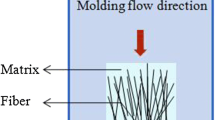Abstract
An analytical approach of to reinforcement for of short fiber reinforced composites has been extended to include the estimation of elastic modulus. The model is based on the theoretical development of shear lag theory developed by Cox for unidirectionally Aligned aligned Short short Fiber fiber Compositescomposites. Thus, the evolution of conventional models is described in detail along with the effect on the modulus of various parameters. Results are shown with experimental data as well as the comparison of other theories. It is found that the present model agrees well with experimental data and resolves some of the discrepancies among the previous models. It is also found that the present model is very accurate yet relatively simple to predict Young’s modulus of discontinuous composites and has the capability to correctly predict the effects of fiber aspect ratio, fiber volume fraction, and fiber/matrix modulus ratio.
Similar content being viewed by others
References
B. D. Agarwal and L. J. Broutman, Analysis and performance of Fiber Composites, John Wiley and Sons, New York, (1980) 71–104.
B. D. Agarwal, J. M. Lifsitz and L. J. Broutman, Elastic-Plastic Element Analysis of Short Fiber Compo-sites, Fiber Science and Technology, 7 (1974) 45–62.
T. W. Clyne, A simple development of the shear lag theory appropriate for composites with a relatively small modulus mismatch,” Materials Science and Engineering A, 122 (1989) 183.
H. L. Cox, The Elasticity and Strength of Paper and Other Fibrous Materials, British Journal of Applied Physics, 3 (1952) 72–79.
J. M. Papazian and P. N. Adler, Tensile Properties of Short Fiber-Reinforced SiC/Al Part I. Effects of Matrix Precipitates, Metallurgical transactions A, 21 (1990) 401–410.
B. Ji and T. Wang, Constitutive Behaviors of Discontinuous Reinforced Composites, Key Engineering Materials, 177–180 (2000) 297–302.
H. G. Kim, “Investigation of Stress Field Evaluated by Elastic-Plastic Analysis in Discontinuous Composites, International Journal of Automobile Technology, 8(4) (2007) 483–491.
M. Taya and R. J. Arsenault, A Comparison between a Shear Lag Type Model and an Eshelby Type Model in Predicting the Mechanical Properties of Short Fiber Composite, Scripta Metallurgica, 21 (1987) 349–354.
M. Taya and R. J. Arsenault, Metal Matrix Composites: Thermomechanical Behavior, Pergamon Press, (1989) 25–28.
H. G. Kim, Effects of Fiber Aspect Ratio Evaluated by Elastic Analysis in Discontinuous Composites, Journal of Mechanical Science and Technology, 22 (2008) 411–419.
J. C. Halpin, Primer on Composite Materials: Analysis, Technomic Publishing Co., Inc., (1984) 130–141.
R. Hill, Elastic Properties of Reinforced Solid: Some Theoretical Principles, Journal of the Mechanics and Physics of Solids, 11 (1963) 357–372.
J. C. Halpin, and J. L. Kardos, The Halpin-Tsai Equations: A Review, Polymer Engineering and Science, 16(5) (1976) 344–352.
M. J. Starink and S. Syngellakis, Shear lag models for discontinuous composites: fibre end stresses and weak interface layers, Materials Science and Engineering A, 270 (1999) 270–277.
M. D. Skibo, Stiffness and Strength of SiC-Al Compo-sites, SAND81-8212, Sandia Laboratory, California, USA, (1981).
H. Jeong, D. K. Hsu, R. E. Shannon and P. K. Liaw, Characterization of Anisotropic Elastic Constants of Silicon-Carbide Particulate Reinforced Aluminum Metal Matrix Composites: Part I. Experiment, Metallurgical Materials transactions A, 25 (1994) 799–809.
Z. Jiang, et al., An analytical study of the influence of thermal residual stresses on the elastic and yield behaviors of short fiber reinforced metal matrix composites, Materials Science and Engineering A, 248 (1998) 256–275.
D. J. Lloyd, International Materials Review, 39 (1994) 1.
D. L. McDanels, Analysis of Stress-Strain, Fracture, and Ductility Behavior of Aluminum Matrix Composites Containing Discontinuous Silicon Carbide Reinforcement, Metallurgical transactions A, 16(6) (1985) 1105–1115.
Author information
Authors and Affiliations
Corresponding author
Additional information
This paper was recommended for publication in revised form by Associate Editor Chongdu Cho
Hong Gun Kim received a B.S. and M.S. degree in Mechanical Engineering from Hanyang University in 1979 and 1984. He then went on to receive his Ph.D. degrees from University of Massachusetts in 1992, respectively. Dr. Kim is currently a Professor at the Department of Mechanical & Automotive Engineering at Jeonju University in jeonju, Korea. He is currently serving as an Editor of the KSAE and KSMTE. Dr. Kim’s research interests are in the area of fuel cell, FEM analysis, mechanical design, and composite mechanics.
Lee Ku Kwac received a B.S. degree in Precision Mechanical Engineering from Chosun University in 1999. He then went on to receive his M.S. and Ph.D. degrees from Chosun University in 2001 and 2005, respectively. Dr. Kwac currently a Professor at the Department of Mechanical & Automotive Engineering at Jeonju University in jeonju, Korea. Dr. Kwac’s research interests are in the area of fuel cell, nano-mechanism, and micro-machining.
Rights and permissions
About this article
Cite this article
Kim, H.G., Kwac, L.K. Evaluation of elastic modulus for unidirectionally aligned short fiber composites. J Mech Sci Technol 23, 54–63 (2009). https://doi.org/10.1007/s12206-008-0810-1
Received:
Revised:
Accepted:
Published:
Issue Date:
DOI: https://doi.org/10.1007/s12206-008-0810-1



